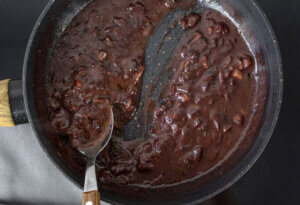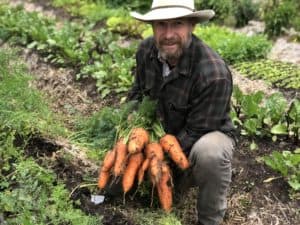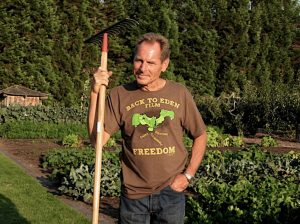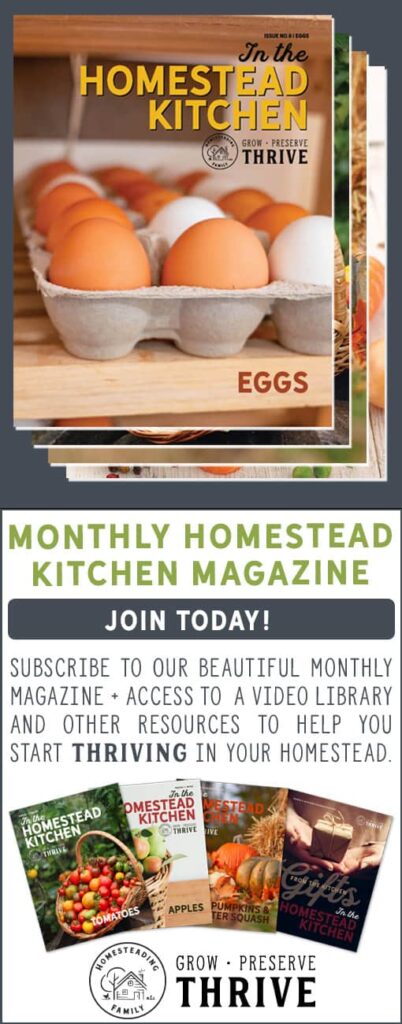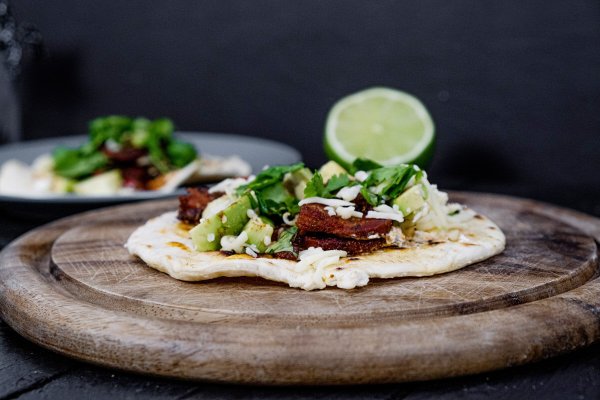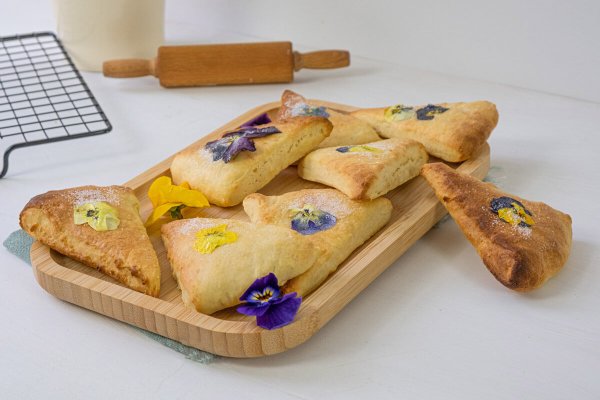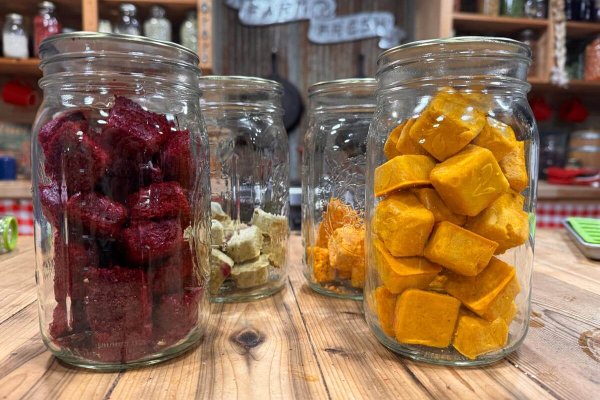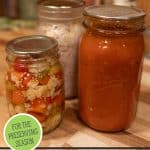

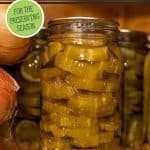


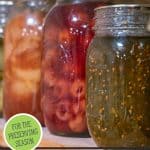
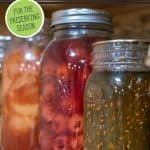
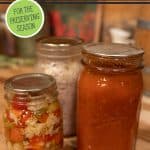
Spring is the best time of year to take inventory of your pantry, get it cleaned out, and prepare it for the new harvest of preserved foods that will be filling up the shelves in summer and fall. Read on for our tips on prepping your pantry for a preserving season without overwhelm.
Listen and Subscribe: Apple Podcasts | Spotify | iHeart | Google Podcasts

One of the most important aspects of a successful homestead is looking ahead. This is why we love this year-at-a-glance of our preserving year in order to build up a well-stocked pantry to feed our family all year long (as well as our 7 pantry staples we’re NEVER without!).
We’re constantly challenged by what needs to be done today, but we need to keep one eye fixed ahead to be prepared for what’s coming in the next few months, and eventually prepared for a full year as well.
With a little planning, it doesn’t need to be overwhelming. Take a look at how simple the end result can be in our full pantry tour.
In this episode of the Pantry Chat, we’re getting practical on ways to prepare your pantry for the coming preserving season. If you need a break from weeding and milking, grab a cold lemonade, sit back, and listen in or watch the video below!
5 Steps to Prepare Your Pantry
- Eat out of the pantry NOW!
- Take inventory
- Clean out the pantry
- Organize the pantry
- Check preserving supplies
Eat Out of the Pantry
This is the time of year to finish off those jars of food (and even frozen cuts of meat) that you haven’t used up. Unsure if your canned goods are still within expiration? We cover that in How Long is Canned Food Good For?
Get creative in the kitchen and eat that food up! If that means you have two sides of veggies, then so be it. And maybe it’s paired up with some sweetbreads, liver, or ox tail to use up those random cuts of meat still lingering in the freezer?
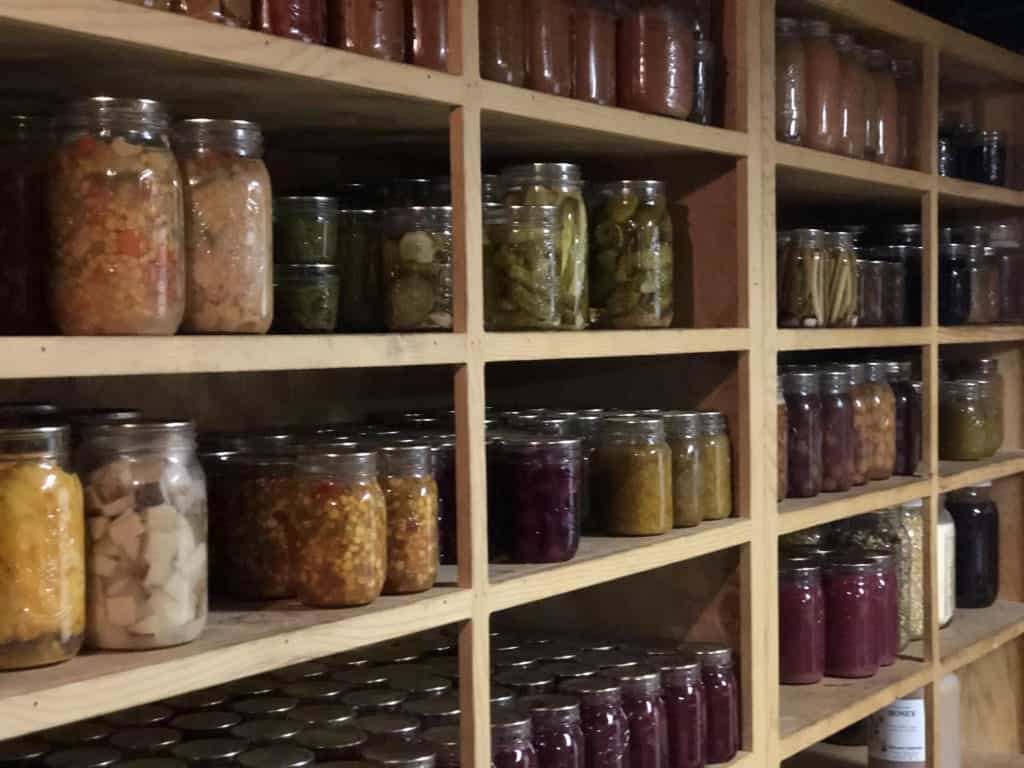
Take Inventory
It’s important to take note of what items you still have in the pantry (perhaps you made a bit too much DIY greens powder last year?), and those items you didn’t even eat.
Make a note to not preserve those items in the future, or preserve fewer servings for the following year. Then, figure out the best way to use them up now (or give them to someone who would enjoy them more than you).
The bottom line is if you’re not going to use the items you preserved, then don’t put your energy into preserving them next year.
Also, take note of what you ran out of too early this year. For us, it was the raspberry jam and the homemade butter that we make and freeze! So this year, when the raspberries are ripe and the milk is overflowing, I’ll be canning more jam and making more butter to get us through the year instead of running out.
Ask your family what they liked and disliked from what you preserved. You might be surprised at some of their favorite items!
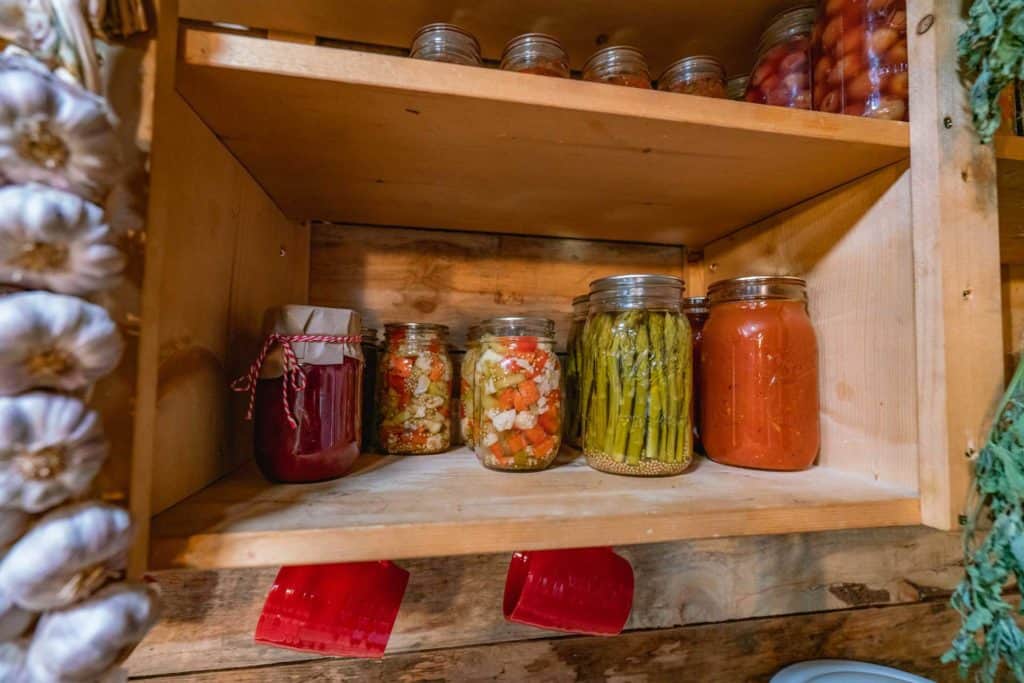
Clean Out the Pantry
This is the best time of year to organize your pantry. Move things around if you didn’t like their location this year, and while you’re at it, wipe down every surface!
You’ll likely never have a pantry as empty as it is right now, so this is the time to do it. Don’t neglect your floors, be sure to give them a good cleaning as well.
TIP: Use your extra lime water from water-glassing your eggs to wash your pantry shelves! Critters and bugs don’t like lime, so wiping your shelves down with this solution is a great option for a natural pest repellent. But use gloves as lime water, after prolonged contact with your skin, can be irritating.
Organize the Pantry
Once you’ve cleaned your pantry, make sure everything gets put back in WITH the item and date listed on the jar.
Arrange your shelf to allow for the new food to be placed behind the old, so you use items up in the right order.
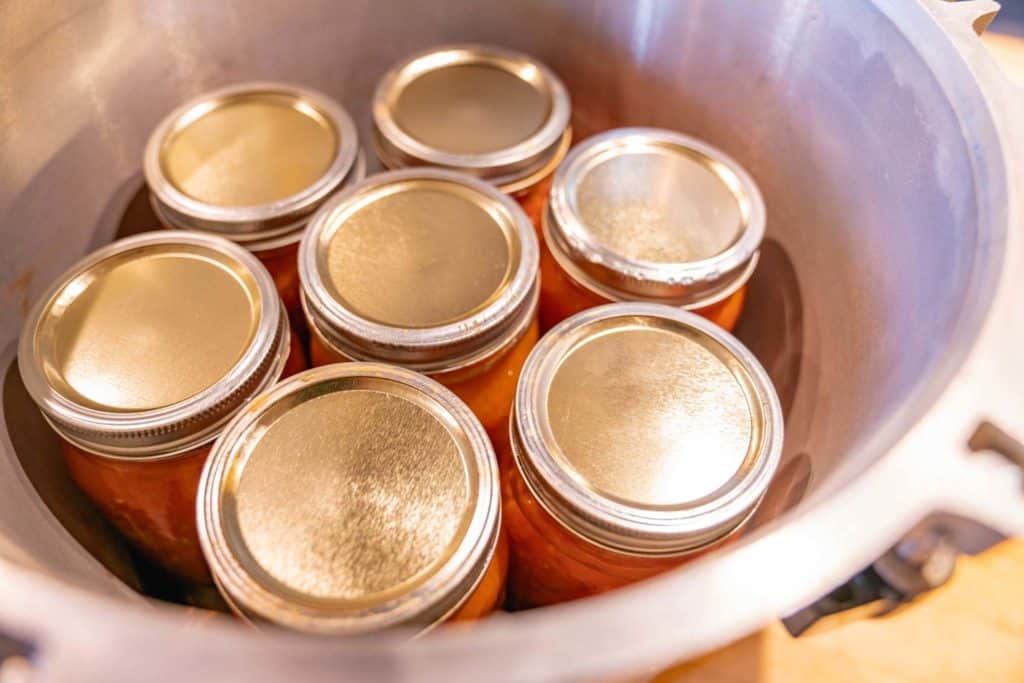
Check Preserving Supplies
This is also the time of year to make sure you’re stocked up on your preserving supplies.
We’ve seen some major supply shortages over the past year, and it’s likely to continue for some time, but there are items that are starting to trickle back onto store shelves, and alternative options to consider such as re-using canning lids.
Take inventory of:
- Canning jars
- Canning lids
- Water bath canners
- Pressure canners
- Dehydrators
If you’re doing a good job cleaning and organizing your pantry now, before the rush of the summer harvest begins, then you’ll be in good shape for a well-stocked and well-organized pantry come fall. For further detail on getting prepped specifically for canning season, be sure to read How to Get Ready for Canning Season.
Josh: Hey guys, this is Josh.
Carolyn: And Carolyn.
Josh: With Homesteading Family, and welcome to this episode of the Pantry Chat: Food for Thought.
Carolyn: This week we're going to be talking about getting your pantry ready for the upcoming preserving season.
Josh: This week's episode of the Pantry Chat is brought to you by BCS Two-wheel Tractors. Now you may have already heard of the legendary versatility of BCS Two-Wheel Tractor for small farms and homesteads. We love ours here on Riverbend. It's the most efficient and time-saving choice for a small acreage. Building raised beds with the rotary plow attachment, mixing and soil amendments with the power harrow, and shredding cover crops in place with the flail mower. But a BCS Two-Wheel Tractor is more than just a gardening tool, BCS powers more than 40 high quality PTO-driven attachments each with the power and performance of an all gear drive transmission. Blow snow with the BCS's snow thrower. Chip and shred limbs and sticks with the chipper shredder.
Josh: Clean up your property with the pressure washer. Haul up to 1100 pounds including yourself with the ride on utility tractor and even spread compost over 30-inch beds with the spreader attachment. Yup, BCS is pretty much the Swiss Army Knife of power equipment for your homestead. Check out bcsamerica.com to see the full range of tractors and attachments and find your nearest BCS dealer today. That's bcsamerica.com. All right, well, today we're going to be diving into prepping your pantry, getting it ready for the upcoming preserving season, which is going to come fast. I mean we're in the heart of spring right now and getting things in the ground, but before you know it, it's going to be time to be putting things up and stocking the pantry.
Carolyn: Right. And there's probably already things starting to trickle into the pantry. I know we've already kind of come through the flush of eggs that come in the spring, early spring. And so there may already be a few things in the pantry, but this is really the time to take advantage of the pantry being at kind of its lowest mark of the year so that we can clean it up and get it all ready for this next season.
Josh: Yeah, absolutely. And before we get into that, I want to catch up on a little chit chat. And it feels like it's been a while, it's been a month on this new schedule. And I'm kind of missing this and wondering what you guys are thinking, how are you guys liking the schedule? Do you want to see more of the Pantry Chats? We used to do them week by week and we had to play around with schedule a little bit. So we went to once a month, I'm kind of missing them.
Carolyn: I feel like I'm kind of missing them, too. I love getting to hang out with you guys, but I really also like just getting to sit here and have a cup of coffee with you and enjoy some moments of talking with you.
Josh: Yeah, it is. It's a nice break in the day from the chores because we've got to get right back up here and I've got some compost to go make next.
Carolyn: Yes, so yeah. And you're actually doing that on video. That's exciting.
Josh: Yeah, that sure is.
Carolyn: Yeah, so we'll be looking for that video to be out. That's really fun.
Josh: Absolutely, yeah. But it's been a while and we can't take too long, but what has been going on with you this past month?
Carolyn: Yeah, well, this is spring. And here in North Idaho, this is really spring. This is when we're really starting to dive in. So I think one of the biggest things were on the homestead that's going on for me is getting the terraces which is our new area of garden.
Josh: Expanding, yup.
Carolyn: We've expanded the garden. We've expanded the cottage garden really is what we've done to include a lot more of a kitchen garden with our fresh eating vegetables that we want throughout the season.
Josh: It gets them a lot closer to the house than the main crop which is behind the house, and this is just a permaculture strategy, right, thinking about where things are.
Carolyn: Right.
Josh: Yeah. And getting them closer to you.
Carolyn: Yeah. And so we are getting that into production right now, and it's really exciting to see little plants coming up in this new area. And I've got to say, there's an element of this terrace garden that I didn't expect that I'm really enjoying. And that is it's out in the front of the house which means it's facing the road. We're actually not far off the road on our property and it's actually facing the road. And so I'm out there working and our neighbors will drive by. And I'll wave and they'll honk. And I've had multiple neighbors now pull into the yard and come and chat for five minutes, just pull in because they see me out there. And they'll come and say hey, how are you doing? The gardens are looking great and just have this quick chat. And so I feel like being out in the front, we're being a little more visible and we're making connections, or I am a little bit more with some of the neighbors whereas usually you just wave and they go on by.
Josh: There's definitely an element of curiosity there.
Carolyn: Yeah, there is.
Josh: Yeah. I don't know that we filmed the terraces, but we had a slope in front of the house. And which is part of it is right directly in front of Carolyn's cottage garden which you guys have probably seen some of the videos on that. And it just was kind of useless ground, the sloping off, too steep to do anything with. And so we put that into terraces and now turning it into a growing place. And so that's looking pretty interesting, it's really going to get curious as it starts developing.
Carolyn: Right, yeah.
Josh: But why don't you share with people what you're putting in there so they know what are the good things to get closer to the kitchen.
Carolyn: Okay, yeah. So some of things that are obviously going in right now are the early spring things. We don't get to plant our main crop until the beginning of June. So we're not-
Josh: Just coming up quick.
Carolyn: It's coming up quick, but we're not yet. So the early spring things have been in there. And those are things like our salad greens, our cooking greens, you want those really close to the kitchen so you can just like trip out, go get a basket full and get them cooked for dinner. Other things are fresh eating tomatoes. Those will go in with the main crop season as we get past all the frosts. Cucumbers, let's see, I've got spinach, chard, some onions going in there for quick use. Not really the storage onions.
Josh: Yeah. This is not our preserving stock. This is for fresh eating.
Carolyn: Yeah, I mean, okay so technically, they're the same onions as we have for preserving for winter but we're pulling these green and eating them fresh.
Josh: Quick grab.
Carolyn: I'm playing with fava beans this year. I have never done fava beans but there's something that can really handle the frost so you need that for a long frost season. So tomatoes, I think I said that, cucumbers.
Josh: Summer squash.
Carolyn: Summer squashes, melons, maybe I'm actually putting some loofah gourds in because it's a really nice warm spot. And I think I may be able to get away with growing [crosstalk 00:06:52] my own exfoliant sponges.
Josh: That would be cool. Keep us updated on that.
Carolyn: I will do that.
Josh: If you can do that here, that would be really, really cool.
Carolyn: Yeah, I'm definitely pushing the season so we'll see.
Josh: Good. What else is going on?
Carolyn: What about you? You take a turn for a second. I got a lot going on.
Josh: Wow, well, you know what? May is the season, we've been getting a lot of the main crop in, in the main garden so focused up there. And from cabbages to broccolis which we're doing more of this year. And that's going to be a challenge because flea beetles are our one major pest ... [crosstalk 00:07:28]
Carolyn: The big one.
Josh: ... problem. Yeah, and so we've been a little shy to go too far with those, but we're putting in two full rows because we really want more of those in storage.
Carolyn: Yeah.
Josh: Yeah. And that's why we'll be working out strategies to deal with those guys. And potatoes, [inaudible 00:07:41] onion, carrots, beets, parsnips are all in. And getting ready for the main planting here in the beginning of June with our beans, our corn, our winter squash. So really working that space and composting, and animals are out and moving.
Carolyn: Yes, yay!
Josh: Yeah. And then we got the pigs just finishing up, prepping one area where the corn and squash is going to go. And get ready to move them over to where they can turn our main compost pile a bit and add to it. And chicken tractor's out, and we're using those chickens to prep some future food forest areas. And not too far off here, the meat chicks are going to come in.
Carolyn: Wow, that's a lot.
Josh: So there's a lot going on. We're in full season.
Carolyn: Okay, and then there's one other thing that I do want to talk about that I have been up to, and that is filming the dairy class. You guys, the more lessons that I film in this class, the more excited I get about it because when I've been making dairy by myself at home, for myself, not to share with you guys, I just squeeze it into the corners of my days. And I really had to sit down when I thought about this class and think about what are the challenges with dairy. And the biggest one for me and I'm assuming for most of you, guys, and let me know in the comments if this is true, is the time. Like who has the time to just add all these hours of cheese and yogurt and butter and all these different amazing things that we want to do with all this dairy into their schedule.
Carolyn: And so I really kind of started breaking down the process and realized, you guys, I can do everything that I need to do for dairy within a couple hours a week. And that is what I am teaching you guys in this class. I'm super excited. I mean sour cream, butter, yogurt, hard cheeses, soft cheeses. If you do it the right way, if you get really practical about it, you can fit it all into a really tight amount of time and it's really exciting. So I'm excited to share this with you guys because I think it's going to make dairy super, super doable on the homestead, whether you have a milk animal or not.
Josh: Right, because you can still buy in good milk and upscale all these products which brings a lot of value into your home because those are high, high dollar products and high nutrient products if you've got good quality milk to start with regardless of whether you're buying it or ...
Carolyn: And I am also talking about what to do, if you can't go out and buy raw milk. I know some places you really can't go get it at this point, but I am talking about what do you do if you just have to go to the grocery store and get milk? So we'll be covering that, too.
Josh: Wow, and as usual, it's going to be a good class.
Carolyn: This is exciting. I'm so excited.
Josh: And I'm sure you'll keep us updated here as it moves along.
Carolyn: Yes, so the release date is going to be in September, but we're going to get a wait list going probably in July. And there's going to be a lot of like specialty stuff in that, special lessons that are exclusive to that wait list. There's going to be a lot of fun stuff in there. And like always because we love you guys. You guys are our people who just hang with us through everything. We're going to make sure you get the best price offer that will ever, ever, ever show up in this class when we first release it because we want to make sure you get the best deal.
Josh: That's if you're on the wait list.
Carolyn: That's going to be right here on the wait list, yeah. [crosstalk 00:11:07].
Josh: You're going to have to get on.
Carolyn: You'll have time.
Josh: You have to sign up via email. [crosstalk 00:11:09]
Carolyn: We'll let you know.
Josh: We'll let you know as soon as that comes out. Yeah. Well, hey, we better ... [crosstalk 00:11:13]
Carolyn: Keep moving.
Josh: ... move along a little bit because we've got a couple of questions before we dive in the main topic. And these look like better butter questions. Better butter. Michael Draconis on how to make butter is asking, since you have had a Bosch Mixer and a KitchenAid, which one do you find to be more reliable and a versatile appliance? The Bosch versus the KitchenAid? And I think I know the answer. [crosstalk 00:11:36]
Carolyn: Yeah, and I'm going to answer not just for butter making, but for everything across the board and it's hands down the Bosch. I just got another KitchenAid. It looks really pretty on my kitchen counter. I actually got it because we have so many bakers now with six daughters in the house and a couple of boys who like baking that we needed a secondary mixer for when we're all in the kitchen working. But hands down, every single one of us grabs the Bosch Mixer when we go to do anything. It is just a workhorse and it holds a lot more and it's lighter, it's quieter. It's just a nicer machine to work with, but it isn't pretty, that's the downside.
Josh: Yeah. But I got to tell you as the guy that's usually behind replacing things, fixing things, solving those types of problems, the Bosch is hands down a workhorse and reliable. And just in our type of context, the KitchenAid is good so far and good for certain things, but when you're working on the homestead and you needed just a good workhorse, the Bosch has held up so well.
Carolyn: I have burned through four KitchenAid's in 15 years. And in about 12 years, I have used that Bosch like crazy and it's never failed me once.
Josh: Yeah. I think we replaced a couple gears. [crosstalk 00:13:02]
Carolyn: Oh yeah, sometimes the beaters, the cookie beaters because the kids like yeah.
Josh: But the motor is still powering through, I mean we've literally burned up the motors on the KitchenAid, so they're good. They've got their right place.
Carolyn: Yeah.
Josh: But great. Good question, Michael.
Carolyn: Good, we probably better just skip on because we're taking a while.
Josh: All righty. So diving in the main topic. We're talking about getting the pantry ready, a little specifically for getting ready for preserving season. And it's kind of a little bit of spring cleaning here so to speak.
Carolyn: Yeah. And this is a really important time of year to do this because you don't want to put your fresh good foods into a dirty pantry. That's just going to invite all sorts of pest issues, mold issues. And while your canned goods, if you can things, may be safe, it's just not a healthy environment to be propagating for food storage. We want to make sure we're working cleanly so that we have healthy long lasting food.
Josh: Besides efficiently using up what you've ... Cycling everything through and making sure stuff isn't getting lost, pushed to the back and just efficiency of use so it's easy for you to go in and get things.
Carolyn: Right.
Josh: Cool. So you want to dive into the points here.
Carolyn: Yeah, let's get going.
Josh: Okay. Point number one that you've got is to get rid of anything you aren't using.
Carolyn: Yeah. So when you go down to your pantry and you're like, hey, I got to start cleaning this out. What do I do first? The first thing is to look through all of the things that you have not been using. We all have those things sitting on the shelf that we're like, I thought my family would love this particular canned good and it's still sitting here. If you're not using it regularly, like unless you have a special reason, which would be I'm saving this for a special holiday, we have things like that.
Josh: Special occasions.
Carolyn: There's special occasion things that we make. If you don't have that reason, if you haven't pulled something in six months, then you need to start thinking about either use it up right now or move it on either to somebody who will use it or maybe it's time to give it to the chickens and get those jars back in circulation if it's a canned good. This is a really the month to be eating out of your pantry. Maybe for most of the country, May, you don't have like sustaining crops coming in yet. You're not eating some of those like staples out of the garden. And so this is a good moment to like, let's eat down the pantry. Let's use it off and really focus on getting those kind of odds and ends used up. And that's true in the freezer too, we're not really talking about the freezer, but the same thing happens in the freezer. There comes a point where you're like, okay, this is the month we're using the sweet breads. [crosstalk 00:15:41]
Josh: The liver, the sweet breads.
Carolyn: And the liver.
Josh: The ox tail. Whatever the random cuts are.
Carolyn: Right, all the little things that have kind of fallen through the cracks. So this is the moment to be using those things.
Josh: Very cool. Okay. Point number two is to sort the remaining items and take note of what you have left.
Carolyn: Yeah. This is really important as you continue to get better and better at your food storage, like management skills so pay attention to what is it that you have a whole lot left of? We got to the end of winter, we're starting to get fresh veggies in or fresh foods in. What is it that you still have a huge stock of? Maybe it's that dehydrated zucchini that you never got around to. I'm looking at myself when I said that because I've got jars of dehydrated zucchini sitting there that I'm still like, well, what did I think I was going to do with this stuff.
Josh: You're going to have a lot of ideas, I'm sure.
Carolyn: Good. Give me your ideas because I've got like three-gallon jars of dehydrated zucchinis that I need to do something with. So really take note of that because if you're not going to use it, don't put the energy into preserving it next year. It's just not worth your time if you're not going to use it. It's better just to give those things to the chickens, give them to a friend, give them to the pigs or focus on using them fresh when they're fresh in season. The other thing you want to take note of is what did you run out of early? What are those big gaps on your shelf that you wish still had something in it? Maybe it's your raspberry jam. I know that's what I just heard from the kids like we need more raspberry jam next year.
Josh: It's one of my favorites.
Carolyn: Yeah. And so make sure you're writing these things down. Just a quick note because four weeks from now, eight weeks from now when you're actually getting those raspberries in from the garden, you need to kind of remember, oh yeah, that's right, I wanted to turn more of these into jam than I did last year. So just make sure that you take note of it. The other thing to pay attention to is what did you or your family not like, but you decided to choke down anyways. Just don't bother. Just don't do it next year because your time is just too valuable for that sort of thing. So taking inventory really of what has happened during the year, during the winter in your eating patterns is super important before you go into the next preserving year.
Josh: Yeah, very cool.
Carolyn: Yeah.
Josh: Good points. Okay. Number three, clean out your space and organize your foods. And you can check out this other Pantry Chat that we have on organizing your pantry specifically, but you've got some discussion points here on cleaning out and organizing.
Carolyn: Yeah. Again, this is the easiest time of year because you have the least amount of stuff, theoretically, in your pantry this time of year before the preserving season starts. So we really want to get everything off every single shelf. I know that's painful, but you know that old spring cleaning mantra was that you touched every single surface. You cleaned off every single surface in your house once a year, so that we're starting fresh every year. And this is really important in the pantry. You start getting cobwebs, you get dust. If you put a jar away sticky, you got a little bit of stickiness stuck to the counter. Maybe somebody spilled some pasta or something like that, you need to clean that stuff up once a year at least. And it's ideal if you want to use a hot soapy water for your shelving to get that really clean, maybe a little bit of vinegar in there, depending on the material that your shelves are made out of.
Josh: Cool.
Carolyn: One trick for you guys, I have a lot of people asking me this time of year, what to do with the leftover lime water from storing your eggs?
Josh: Okay.
Carolyn: Okay. Historically, that would be turned into a whitewash and pantries would be whitewashed.
Josh: Really, that makes sense.
Carolyn: The reason for that is lime deters critters. Things don't like lime. It is antibacterial, it's antifungal.
Josh: And it's highly alkaline.
Carolyn: And because it's very alkaline, things can't live in it very well. So this is a great thing to do with it. It may color your shelves a little bit white, so be aware of that. But if they're just pantry shelves and you're okay with it, use a little bit of that on the sponge to wipe things down. Just remember, make sure you've got rubber gloves on because it's very alkaline. It will dry out and ultimately burn your hands if your hands are in it too often, but it'll be fine as soon as it's dry on the shelf.
Josh: We should do a video sometime on old white washing or [crosstalk 00:20:22] just all of that and how to make it and how it was used because that's really, that's kind of fell to the wayside. But that was actually very important. It wasn't just about making everything white.
Carolyn: Right, exactly. No, it was a cleaning agent done once a year to really disinfect into cleaning areas [crosstalk 00:20:35] and it's really important. [crosstalk 00:20:36]
Josh: Let us know if you guys would be interested in that. I think that's an interesting topic.
Carolyn: I think that would be. Yeah, we should whitewash. We haven't actually done the full whitewash, which has a few other steps than just the lime water, but it's really good. So don't forget your floors, like clean the entire area while you're there. Spend some time, just get it done. You're going to love being in your pantry the next year. Honestly, there's a psychological side to your pantry. As you see those jars going in or maybe those dehydrated foods or those fermented foods, it really gives us a real sense of satisfaction. And especially as a mom, I've got to say so many things that we do as a mom disappear, they get undone instantly. You clean the kitchen and it's instantly a wreck again. You make a great meal and it's gone in less time than it took you to make it. And so seeing your pantry just always feel so satisfying. So making it a nice place by making sure it's nice and clean really adds to that.
Josh: I really love good clean spaces. Okay.
Carolyn: Good. Oh, sorry, then we need to put everything away.
Josh: Oh, right.
Carolyn: Here's the thing, make sure it's labeled. Make sure it's labeled. Always, always, always label it. Even if you didn't label it, when you put it on your shelf. At least label the year that you canned it. If you're like, I just know those are green beans. There's nothing I could confuse them with. Please make sure when you put it back in that they at least have the year [crosstalk 00:22:01] written on the label.
Josh: Yeah, so make sure you're using things up in a timely manner.
Carolyn: Yeah, and you should be able to rotate out your stock so just double check that.
Josh: Very cool.
Carolyn: All right.
Josh: All righty. And last point here, check your preserving supplies. Get ready.
Carolyn: Yes. And this is a really good time of year to make sure you're totally stocked up on your preserving supplies. Now for me, I like to keep a lot of my supplies right in my pantry. My empty jars go right back in onto a different pantry shelf for storage. So they're easy for me to grab later, but they said this year, there's some challenges on finding the supplies. They're starting to trickle back into the market in some places. Some places, they're still hard to find. But right now, they're out there if you just start looking, so make sure you're looking for your supplies and get your entire year's worth right now and add those to your pantry so that you're ready to preserve for the whole year. We have a video on that, on getting stocked up at least for your canning year. So keep an eye out for that. It's up here somewhere. Again, just make sure you're getting ahead because we need to make sure you have the supplies now before everybody else thinks about their preserving year, so [crosstalk 00:23:29] go find it.
Josh: Yeah, just take a little action ahead of time is really, really helpful.
Carolyn: Yeah. Good. Well, following these steps, you guys will help you be ready when that rush of preserving season actually comes on, which is important to be ready for it in advance. So you can just fill up the pantry and move on.
Josh: It has been great hanging with you guys. We'll see you soon.
Carolyn: Hey, check out that video on getting all of your canning supplies right there.
Josh: Thanks for listening to this episode of the Pantry Chat: Food for Thought. If you've enjoyed this episode, please subscribe, rate and review.
Carolyn: To view the show notes and any other resources mentioned on this episode, you can learn more @homesteadingfamily.com/podcast.
Josh: We'll see you soon.
Carolyn: Goodbye.
Sign up to receive email updates
Enter your name and email address below and I'll send you periodic updates about the podcast.
Resources & Related Links:
- Sponsor: BCS Two-wheel Tractors
- Bosch Mixer
- How to Build a Compost Sifter
- Garden Planning for Serious Food Production
- How to Make Butter – 3 Easy Homemade Methods
- Where To Find Canning Supplies When There’s a Shortage
- Meal Planning on the Homestead (Eating Seasonally)
- 3 Things You Must Do To Increase Self-Sufficiency
- What To Do In An Emergency Until Help Arrives!


